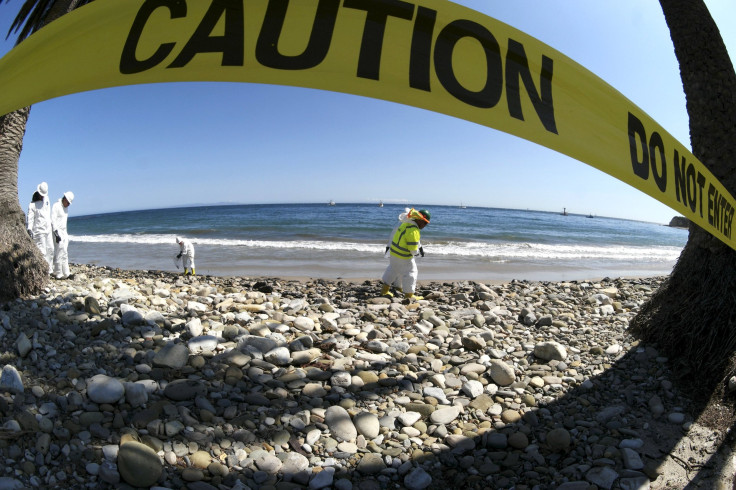California Oil Spill: Tally Of Oil-Soaked Wildlife, Alive And Dead, Mounts In California

LOS ANGELES (Reuters) - The carcasses of five petroleum-soaked pelicans have been recovered from California's Santa Barbara coastline, the first apparent sea bird fatalities stemming from the oil spill to be documented by officials overseeing the disaster response.
The tally was reported Friday by the joint-agency command for cleanup and recovery operations in Santa Barbara and Dr. Michael Ziccardi, a veterinarian from the University of California, Davis, who heads the Oiled Wildlife Care Network.
The body of a dolphin with no visible signs of oil also turned up on Friday in Santa Barbara Harbor, though a post-mortem exam must be conducted on the carcasses of the dolphin and birds to determine conclusively whether or not they were victims of the spill.
The harbor lies roughly 25 miles to the east of the origin of the spill at Refugio State Beach.
So far, a greater number of presumed oil spill casualties have been found alive - at least among sea birds and marine mammals - since the pipeline rupture on Tuesday that unleashed the spill.
Eight oil-stained pelicans have been rescued from the spill zone, along with two surviving sea lions and one elephant seal that were contaminated, Ziccardi and the joint command said.
Six pelicans were sent earlier in the week to a wildlife care center in Los Angeles, about 150 miles away, to be cleaned and nursed back to health, and the two others were on their way.
Each bird arrived coated from the tip of its beak and throat pouch to tail feathers and webbed feet in sticky, black grime, a condition that would ultimately prove lethal for the creatures.
Oil impairs the insulating properties of birds' feathers, exposing them to cold and making it difficult for them to float, swim and fly. Chemicals in the crude petroleum also can burn their skin and irritate their eyes, and they end up ingesting the oil as they preen, damaging their digestive tracts.
Teams of wildlife experts garbed in protective suits and face gear spent hours methodically scrubbing and dousing the pelicans plumage and skin, holding fast to their elongated beaks as the birds wriggled and squinted in discomfort.
By the end of the process, the pelicans emerged looking miraculously restored.
Separately, one of the two petroleum-streaked sea lions rescued from the stricken area was shipped on Thursday to the SeaWorld theme park in San Diego for rehabilitation. Footage released on Friday showed the young marine mammal clean and slick after his bathing at SeaWorld.
The whereabouts of the second rescued sea lion and the captured elephant sea were not immediately known.
A network of volunteers and wildlife rescue workers were deployed to the Santa Barbara coast immediately after the spill, which dumped an estimated 1,700 to 2,500 barrels of oil onto the shoreline and into the ocean.
While the full extent of the toll on wildlife has yet to be determined, experts fear that the oiled birds and marine mammals found so far may be the tip of a potential calamity.
The spill was the largest to hit the ecologically sensitive shoreline northwest of Los Angeles since a massive 1969 blowout dumped up to 100,000 barrels into the Santa Barbara Channel.
That disaster, which dwarfs Tuesday's accident, killed thousands of sea birds and other wildlife and helped spark the modern U.S. environmental movement.
(Writing by Steve Gorman in Los Angeles; Editing by Robert Birsel and Michael Perry)
© Copyright Thomson Reuters 2024. All rights reserved.





















